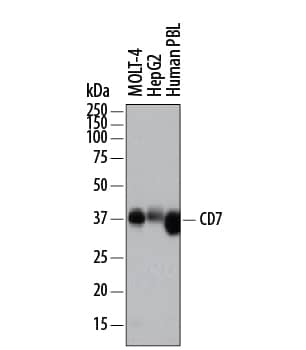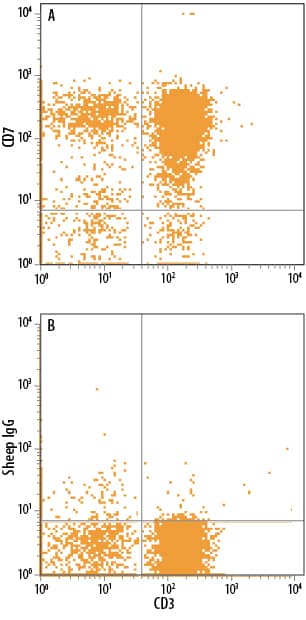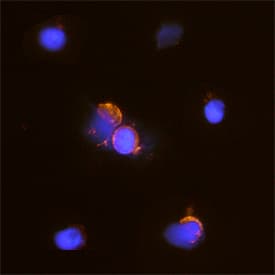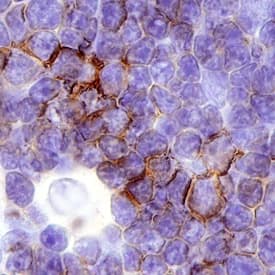Human CD7 Antibody Summary
Ala26-Pro180
Accession # P09564
Customers also Viewed
Applications
Please Note: Optimal dilutions should be determined by each laboratory for each application. General Protocols are available in the Technical Information section on our website.
Scientific Data
 View Larger
View Larger
Detection of Human CD7 by Western Blot. Western blot shows lysates of MOLT-4 human acute lymphoblastic leukemia cell line, HepG2 human hepatocellular carcinoma cell line, and human peripheral blood lymphocytes (PBL). PVDF membrane was probed with 0.5 µg/mL of Sheep Anti-Human CD7 Antigen Affinity-purified Polyclonal Antibody (Catalog # AF7579) followed by HRP-conjugated Anti-Sheep IgG Secondary Antibody (Catalog # HAF016). A specific band was detected for CD7 at approximately 35-40 kDa (as indicated). This experiment was conducted under reducing conditions and using Immunoblot Buffer Group 1.
 View Larger
View Larger
Detection of CD7 in Human PBMCs by Flow Cytometry. Human peripheral blood mononuclear cells (PBMCs) were stained with Mouse Anti-Human CD3e APC-conjugated Monoclonal Antibody (Catalog # FAB100A) and either (A) Sheep Anti-Human CD7 Antigen Affinity-purified Polyclonal Antibody (Catalog # AF7579) or (B) Sheep IgG Control (Catalog # 5-001-A) followed by Phycoerythrin-conjugated Anti-Sheep IgG Secondary Antibody (Catalog # F0126).
 View Larger
View Larger
CD7 in Human PBMCs. CD7 was detected in immersion fixed human peripheral blood mononuclear cells (PBMCs) using Sheep Anti-Human CD7 Antigen Affinity-purified Polyclonal Antibody (Catalog # AF7579) at 15 µg/mL for 3 hours at room temperature. Cells were stained using the Northern-Lights™ 557-conjugated Anti-Sheep IgG Secondary Antibody (red; Catalog # NL010) and counterstained with DAPI (blue). Specific staining was localized to cytoplasm and plasma membrane. View our protocol for Fluorescent ICC Staining of Cells on Coverslips.
 View Larger
View Larger
CD7 in Human Thymus. CD7 was detected in immersion fixed paraffin-embedded sections of human thymus using Sheep Anti-Human CD7 Antigen Affinity-purified Polyclonal Antibody (Catalog # AF7579) at 3 µg/mL overnight at 4 °C. Before incubation with the primary antibody, tissue was subjected to heat-induced epitope retrieval using Antigen Retrieval Reagent-Basic (Catalog # CTS013). Tissue was stained using the Anti-Sheep HRP-DAB Cell & Tissue Staining Kit (brown; Catalog # CTS019) and counterstained with hematoxylin (blue). Specific staining was localized to the plasma membrane. View our protocol for Chromogenic IHC Staining of Paraffin-embedded Tissue Sections.
Preparation and Storage
- 12 months from date of receipt, -20 to -70 °C as supplied.
- 1 month, 2 to 8 °C under sterile conditions after reconstitution.
- 6 months, -20 to -70 °C under sterile conditions after reconstitution.
Background: CD7
CD7 (Cluster of Differentiation Antigen 7; also Leu-9, TP41 and GP40) is a 40-44 kDa member of the Ig-superfamily of proteins. It shows restricted expression, being found on fetal thymocytes, CD34+ myeloid and lymphoid progenitor cells, memory CLA- CD45RA+ T cells, and CD56+ IFN-gamma secreting NK cells. CD7 binds to both SECTM1/K12 and galectin-1, and when bound to the latter, initiates complex formation with CD43 in cis. Activation of CD7 may result in either cell proliferation or apoptosis, suggesting a context-dependent signaling mechanism. Mature human CD7 is a 215 amino acid (aa) type I transmembrane glycoprotein. It contains a 155 aa extracellular region (aa 26-180) that shows one V-type Ig-like domain (aa 26-130), and a 39 aa C-terminal cytoplasmic domain. There is one potential alternative splice variant that contains a 79 aa substitution for aa 133-240. Over aa 26-180, human CD7 shares only 43% aa sequence identity with mouse CD7.
Product Datasheets
Citations for Human CD7 Antibody
R&D Systems personnel manually curate a database that contains references using R&D Systems products. The data collected includes not only links to publications in PubMed, but also provides information about sample types, species, and experimental conditions.
2
Citations: Showing 1 - 2
Filter your results:
Filter by:
-
T-cell functionality testing is highly relevant to developing novel immuno-tracers monitoring T cells in the context of immunotherapies and revealed CD7 as an attractive target
Authors: KE Mayer, S Mall, N Yusufi, D Gosmann, K Steiger, L Russelli, HO Bianchi, S Audehm, R Wagner, E Bräunlein, A Stelzl, F Bassermann, W Weichert, W Weber, M Schwaiger, C D'Alessand, AM Krackhardt
Theranostics, 2018-11-28;8(21):6070-6087.
Species: Human
Sample Types: Whole Cells
Applications: Flow Cytometry -
Dysregulation of tryptophan catabolism at the host-skin microbiota interface in hidradenitis suppurativa
Authors: Laure Guenin-Macé, Jean-David Morel, Jean-Marc Doisne, Angèle Schiavo, Lysiane Boulet, Véronique Mayau et al.
JCI Insight
FAQs
No product specific FAQs exist for this product, however you may
View all Antibody FAQsIsotype Controls
Reconstitution Buffers
Secondary Antibodies
Reviews for Human CD7 Antibody
There are currently no reviews for this product. Be the first to review Human CD7 Antibody and earn rewards!
Have you used Human CD7 Antibody?
Submit a review and receive an Amazon gift card.
$25/€18/£15/$25CAN/¥75 Yuan/¥2500 Yen for a review with an image
$10/€7/£6/$10 CAD/¥70 Yuan/¥1110 Yen for a review without an image






